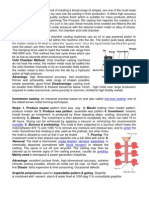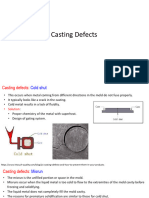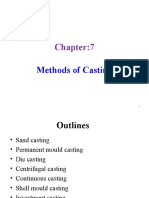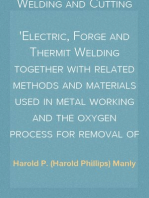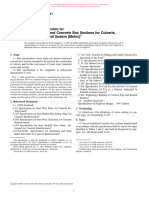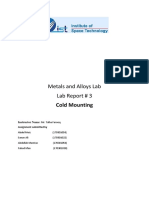Metal Casting Processes
Uploaded by
shreyrana1011Metal Casting Processes
Uploaded by
shreyrana1011Investment casting Permanent mold process
In this casting process, a pattern made of wax is coated with a refractory Disadvantage of expendable molding processes is that for every casting a
material to make the mold surface, after which the wax is melted away while new mold is required.
pouring the molten metal.
Permanent mold processes:
“Investment” means “to cover completely” which refers to the coating of the
•using only metal mold for casting
refractory material around the wax pattern.
• Molds are generally made of steel, CI
This is a precision casting process. Using this we can make castings of high
accuracy with intricate details. •materials that can be cast: Al, Mg, Cu based alloys, CI (affect the moldlife,
hence not used)
•cores are also made of metal, but if sand is used then called semi
permanent-mold casting
•Advantages: good surface finish, dimension tolerance, rapid solidification
causes fine grains to form giving stronger products
•limitations: restricted to simple part geometries, low melting point metals,
mold cost is high. Best suitable for small, large number of parts
M.P. Groover, Fundamental of modern manufacturing Materials, Processes and systems, 4ed
M.P. Groover, Fundamental of modern manufacturing Materials, Processes and systems, 4ed
Steps in permanent mold process
Pre-
heated
mold
Preheating facilitates metal flow through the gating system and
into the cavity.
The coatings aid heat dissipation and lubricate the mold
•Wax patterns are first made
surfaces for easier separation of the cast product
• several patterns can be attached to a sprue to form a pattern tree, if required
• the pattern tree is coated with a thin layer of refractory material and later covered with
thick coating to make the rigid full mold
•Heating of mold in inverted position to melt the wax and permit it to drip out of the
cavity
•the mold is preheated to a high temperature so that contaminants are eliminated from
the mold
• the molten metal is poured and it solidifies
• the mold is removed from the finished casting
Die casting Centrifugal casting
In this process, high pressure of app. 7 to 350 MPa is used to pressurize the molten -In this method, the mold is rotated at high speed so that the molten metal is
metal into die cavity. The pressure is maintained during solidification. distributed by the centrifugal force to the outer regions of the die cavity
Category: hot chamber machines, cold chamber machines
-includes : true centrifugal casting, semicentrifugal casting
hot chamber machines:
-Molten metal is melted in a container attached to the machine, and a piston True centrifugal casting:
is used to pressurize metal under high pressure into the die. Typical injection
pressures are between 7 and 35 MPa.
- Production rate of 500 parts/hour are common.
-Injection system is submerged into the molten metal and hence pose
problem of chemical attack on the machine components. Suitable for zinc,
tin, lead, Mg.
-Molten metal is poured into a rotating mold to produce a tubular part
(pipes, tubes, bushings, and rings)
-Molten metal is poured into a horizontal rotating mold at one end. The high-
speed rotation results in centrifugal forces that cause the metal to take the
shape of the mold cavity. The outside shape of the casting can be non-
round, but inside shape of the casting is perfectly round, due to the radial
symmetry w.r.t. forces
Steps in hot chamber casting
M.P. Groover, Fundamental of modern manufacturing Materials, Processes and systems, 4ed
cold chamber machines: Defects in sand castings
- Molten metal is poured from an external unheated container into the mold cavity and
piston is used to inject the molten metal into the die cavity.
- Injection pressure: 14 to 140 MPa.
- Though it is a high production operation, it is not as fast as hot chamber machines.
Steps in cold chamber casting
Sand blow and Pinholes: defect consisting of a balloon-shaped gas cavity or
gas cavities caused by release of mold gases during pouring. It is present
just below the casting top surface. Low permeability, bad gas venting, and
Die casting molds are made of tool steel, mold steel, maraging steels. Tungsten and high moisture content of the sand mold are the usual causes.
molybdenum with good refractory qualities are also used for die cast steel, CI.
Sand wash: surface dip that results from erosion of the sand mold during
Advantages of die casting:
pouring. This contour is formed in the surface of the final cast part.
-high production rates and economical
- Close tolerances possible of the order of ±0.076 mm
- thin section with 0.5 mm can be made Scab: It is caused by portions of the mold surface flaking off during
-small grain size and good strength casting can be made because of rapid solidification and gets embedded in the casting surface.
cooling
M.P. Groover, Fundamental of modern manufacturing Materials, Processes and systems, 4ed
Penetration: surface defect that occurs when the liquid penetrates into the
sand mold as the fluidity of liquid metal is high, After solidifying, the casting
surface consists of a mixture of sand and metal. Harder ramming of sand
mold minimize this defect.
Mold shift: defect caused by displacement of the mold cope in sideward
direction relative to the drag. This results in a step in the cast product at the
parting line.
Core shift: displacement of core vertically. Core shift and mold shift are
caused by buoyancy of the molten metal.
Mold crack: ‘fin’ like defect in cast part that occurs when mold strength is very
less, and a crack develops, through which liquid metal can seep.
Common defects in casting
Misruns: castings that solidify before completely filling the mold cavity. This occurs because of
(1) low fluidity of the molten metal, (2) low pouring temperature, (3) slow pouring, (4) thinner
cross-section of the mold cavity.
Cold Shuts: This defect occurs when two portions of the metal flow together but no fusion occurs
between them due to premature freezing.
Cold shots: forming of solid globules of metal that are entrapped in the casting. Proper pouring
procedures and gating system designs can prevent this defect.
Shrinkage cavity: cavity in the surface or an internal void in the casting, caused by solidification
shrinkage that restricts the amount of molten metal present in the last region to freeze. It is
sometimes called as ‘pipe’. Proper riser design can solve this problem.
Microporosity: network of small voids distributed throughout the casting caused by localized
solidification shrinkage of the final molten metal.
M.P. Groover, Fundamental of modern manufacturing Materials, Processes and systems, 4ed
You might also like
- SAE-J524, 525, 526, 365 Tubing Pressure RatingNo ratings yetSAE-J524, 525, 526, 365 Tubing Pressure Rating1 page
- The Essentials of Material Science and Technology for EngineersFrom EverandThe Essentials of Material Science and Technology for Engineers5/5 (1)
- Metal Casting Processes: Chapter 11-Part 2No ratings yetMetal Casting Processes: Chapter 11-Part 265 pages
- Permanent Mold Casting Processes: Usually Made From Metal Gas Pressure or A Vacuum UsedNo ratings yetPermanent Mold Casting Processes: Usually Made From Metal Gas Pressure or A Vacuum Used57 pages
- Chapter 2 Casting: Manufacturing ProcessesNo ratings yetChapter 2 Casting: Manufacturing Processes52 pages
- Metal Casting Process (Engineering Workshop)No ratings yetMetal Casting Process (Engineering Workshop)35 pages
- Manufacturing Process 1 (Casting Processes (B.eng) - 10092014No ratings yetManufacturing Process 1 (Casting Processes (B.eng) - 10092014129 pages
- Valery Marinov Manufacturing Technology PDF50% (2)Valery Marinov Manufacturing Technology PDF168 pages
- Manufacturing Technology - I Course ID: ME 222 (3-0-0-6)No ratings yetManufacturing Technology - I Course ID: ME 222 (3-0-0-6)33 pages
- Metal Casting Processes: 3.1 Introduction of Casting Process100% (1)Metal Casting Processes: 3.1 Introduction of Casting Process14 pages
- I. Materials in Manufacturing: Sand CastingNo ratings yetI. Materials in Manufacturing: Sand Casting3 pages
- Picture General Description Pros Cons Cost Surface Expendable Mold, Permanent PatternNo ratings yetPicture General Description Pros Cons Cost Surface Expendable Mold, Permanent Pattern1 page
- Production Technology Lecture Notes 2022-23 - NewNo ratings yetProduction Technology Lecture Notes 2022-23 - New148 pages
- Learn Critical Aspects of Pattern and Mould Making in FoundryFrom EverandLearn Critical Aspects of Pattern and Mould Making in FoundryNo ratings yet
- Color Atlas Basic Technique for Metal Ceramics: An Introduction to Ceramic TechniqueFrom EverandColor Atlas Basic Technique for Metal Ceramics: An Introduction to Ceramic TechniqueNo ratings yet
- Oxy-Acetylene Welding and Cutting Electric, Forge and Thermit Welding together with related methods and materials used in metal working and the oxygen process for removal of carbonFrom EverandOxy-Acetylene Welding and Cutting Electric, Forge and Thermit Welding together with related methods and materials used in metal working and the oxygen process for removal of carbonNo ratings yet
- Hawane House - For Information - Working DrawingsNo ratings yetHawane House - For Information - Working Drawings1 page
- Proposed Three-Storey Building: General Structural / Construction Notes and SpecificationsNo ratings yetProposed Three-Storey Building: General Structural / Construction Notes and Specifications1 page
- Method Statement Riyadh School Project Fire Fighting SystemNo ratings yetMethod Statement Riyadh School Project Fire Fighting System3 pages
- Seismic Performance of Reinforced Concrete Columns With 90 Degree End Hooks For Shear Reinforcement Under High Speed LoadingNo ratings yetSeismic Performance of Reinforced Concrete Columns With 90 Degree End Hooks For Shear Reinforcement Under High Speed Loading7 pages
- The Impact of Geometric Arrange of Brbs On The Dynamic Analysis of StructureNo ratings yetThe Impact of Geometric Arrange of Brbs On The Dynamic Analysis of Structure7 pages
- Quality Conformance Awareness Training: For Brick - Work100% (1)Quality Conformance Awareness Training: For Brick - Work29 pages
- Reinforced Elastomeric Bearing Table Type BNo ratings yetReinforced Elastomeric Bearing Table Type B9 pages


















